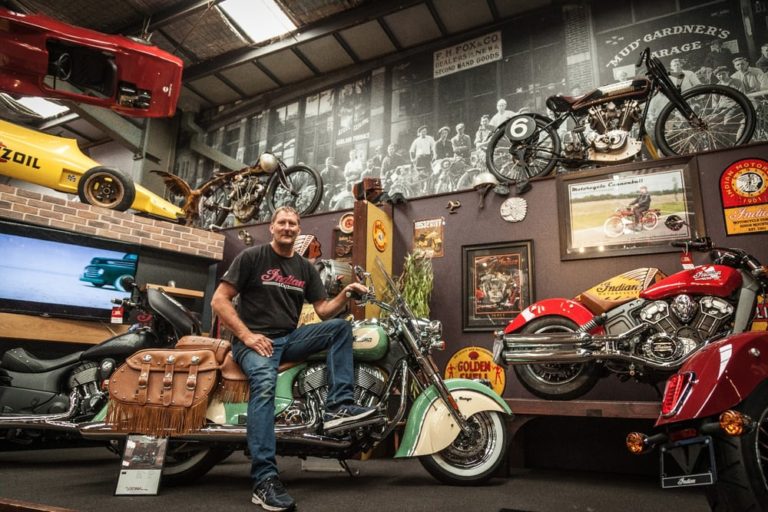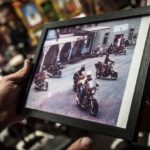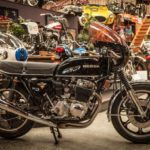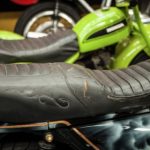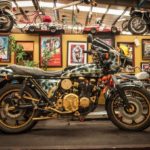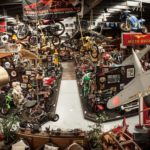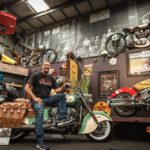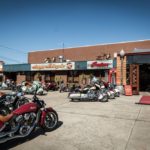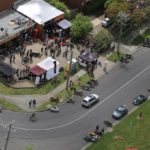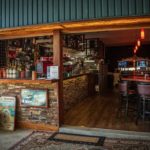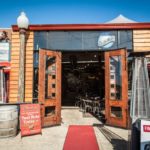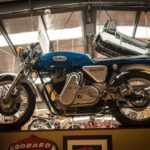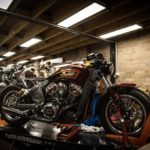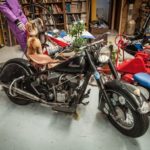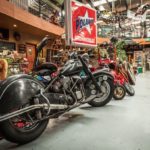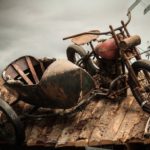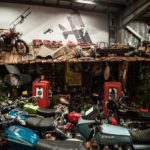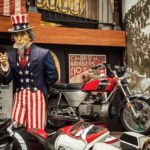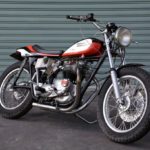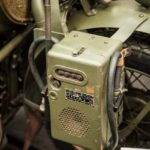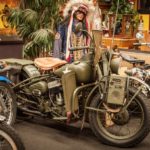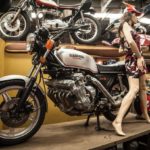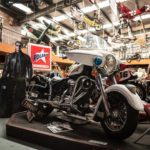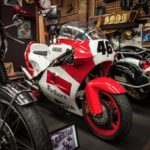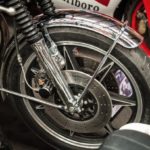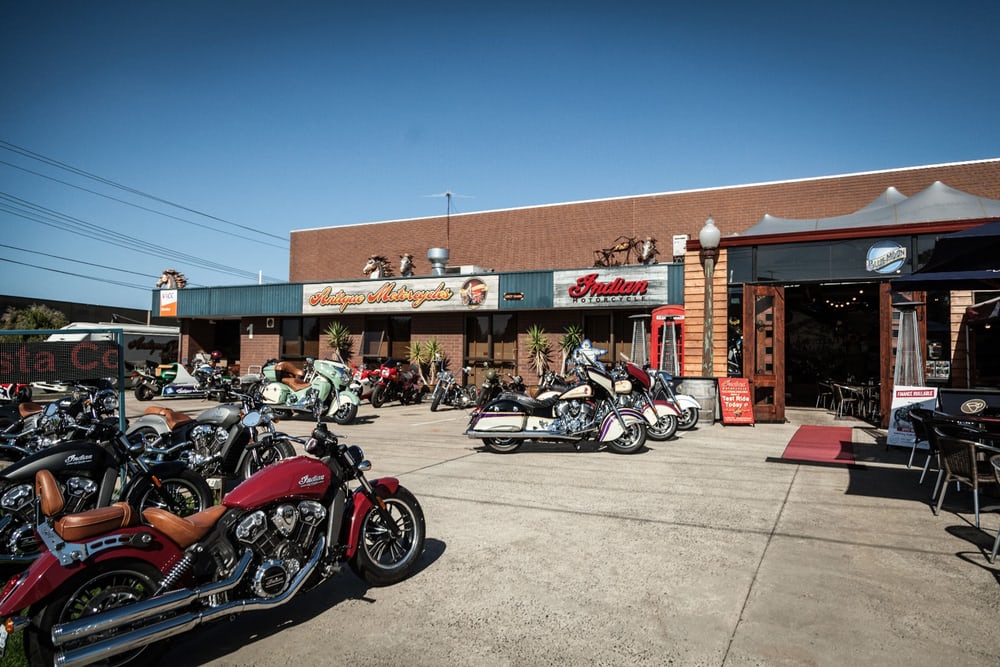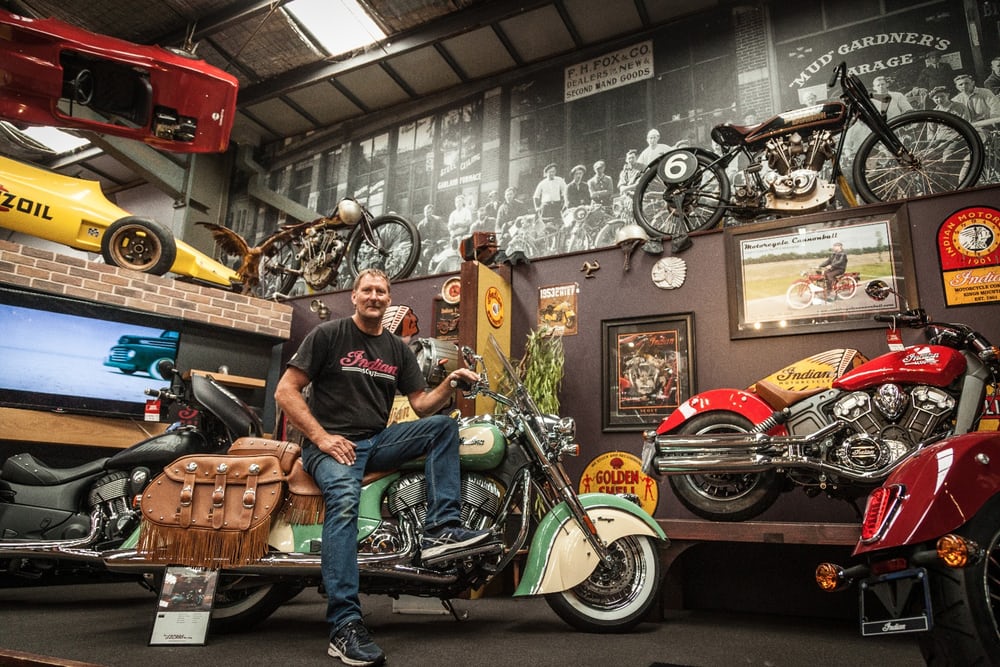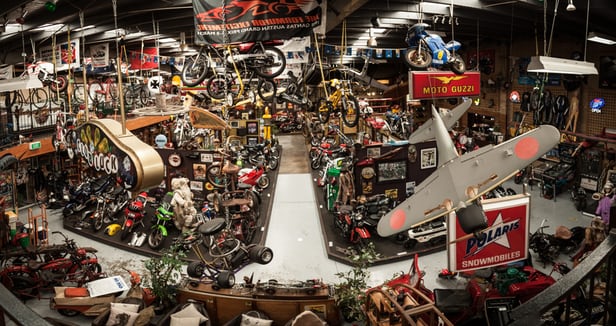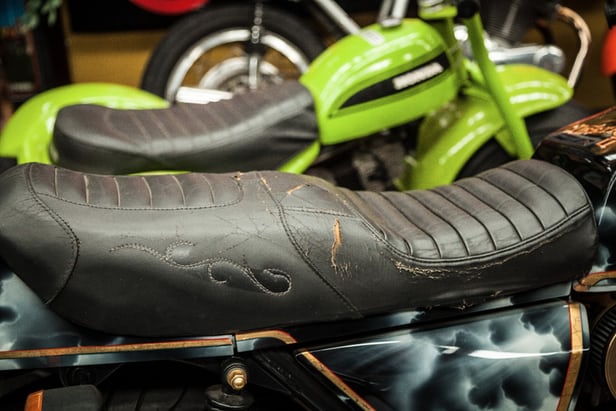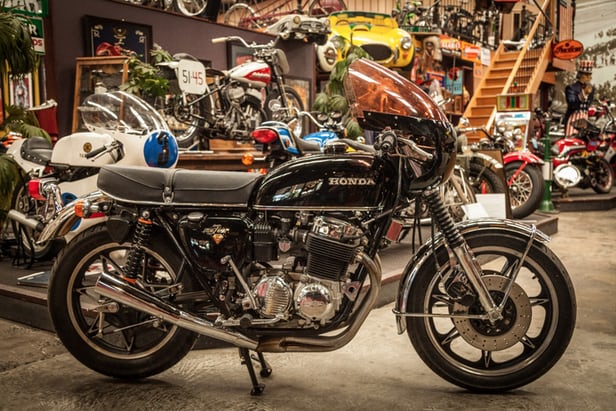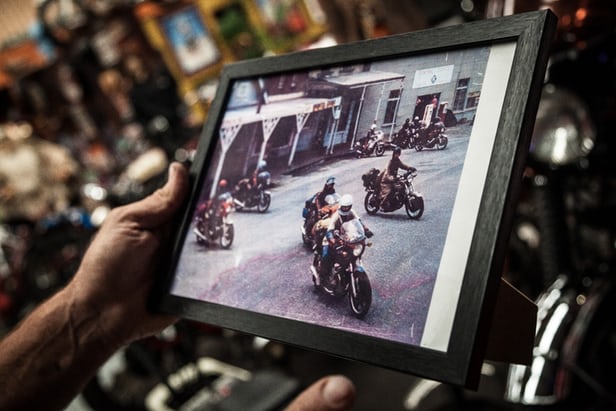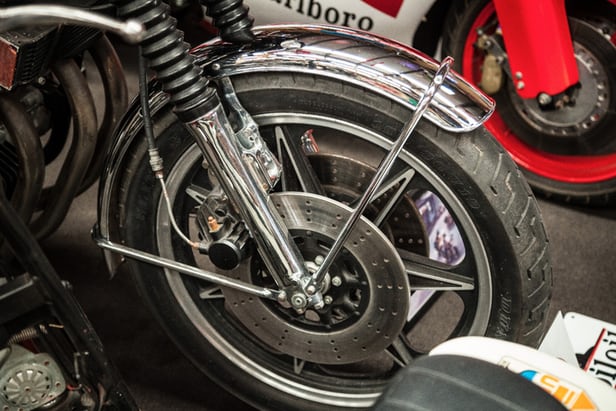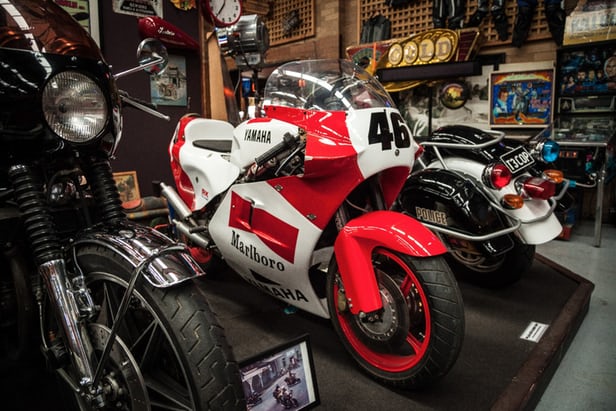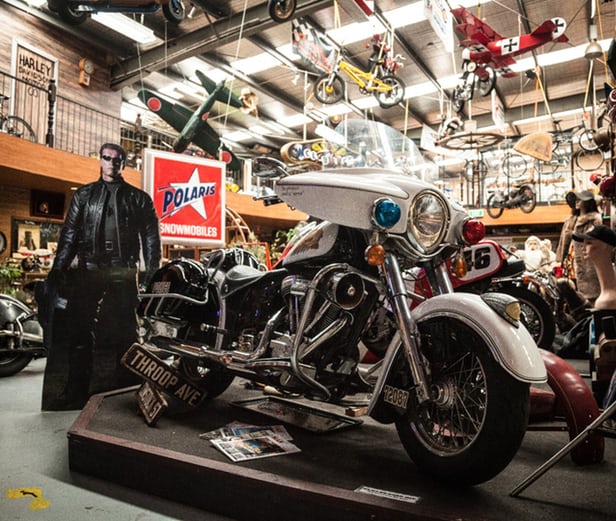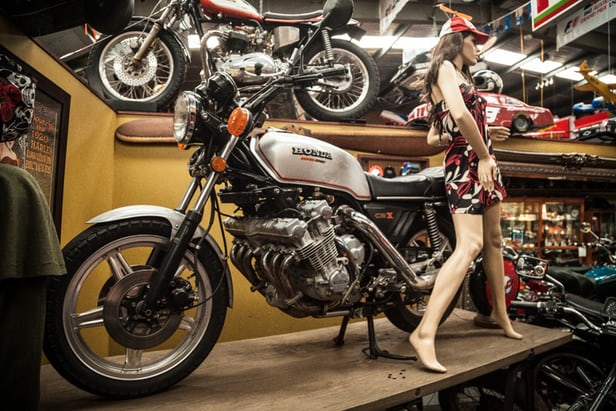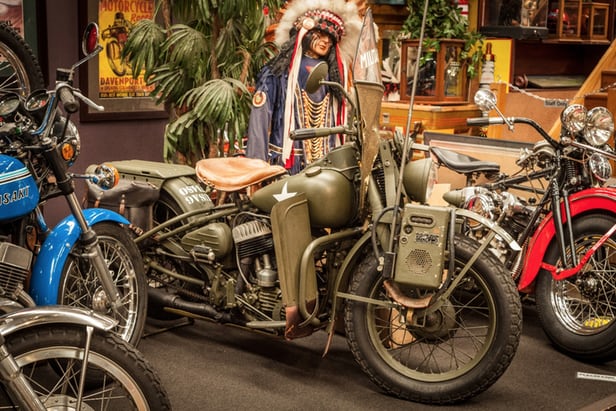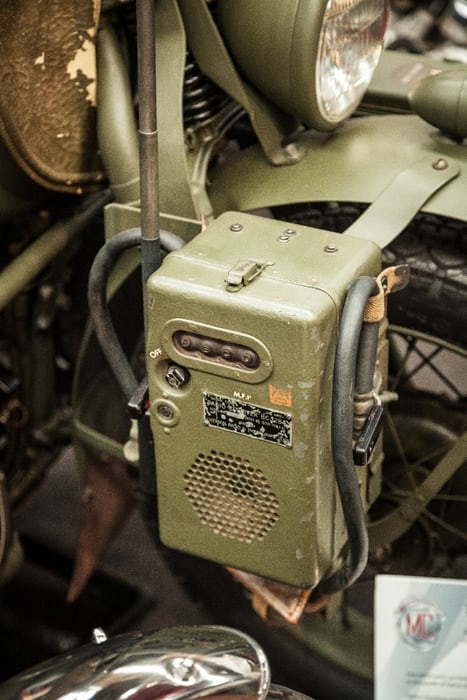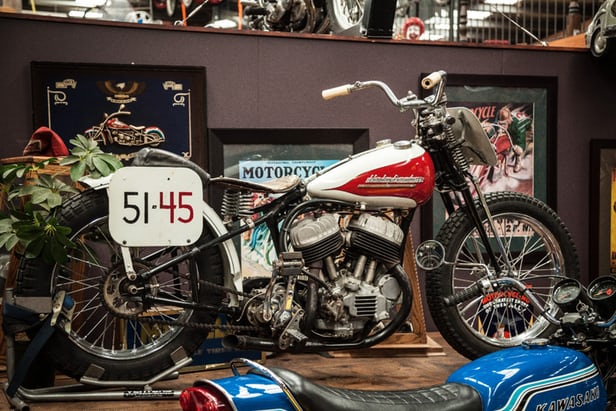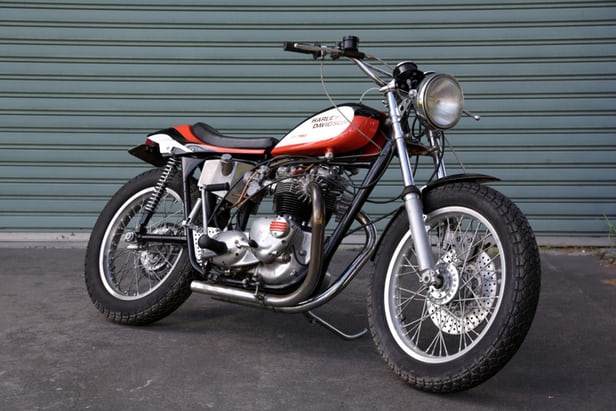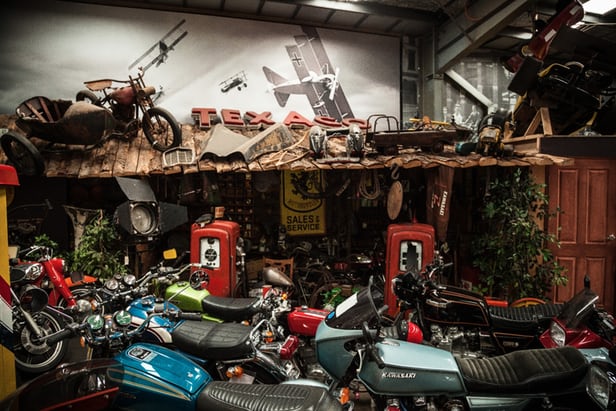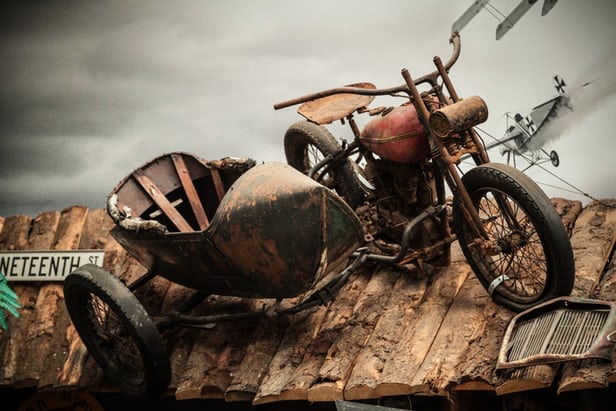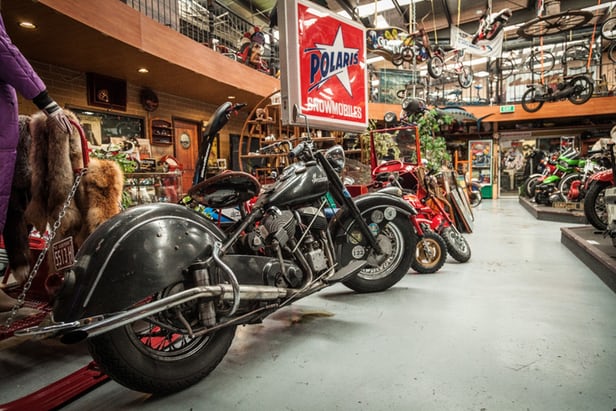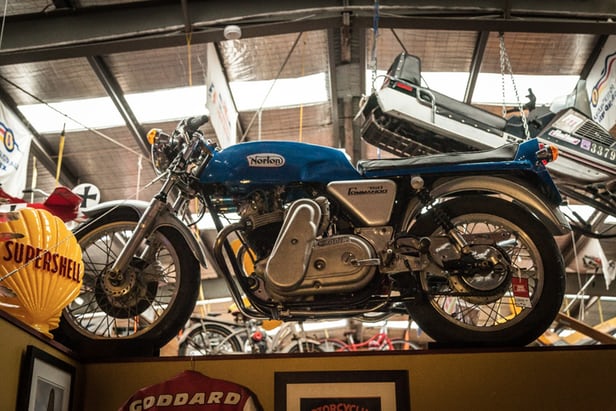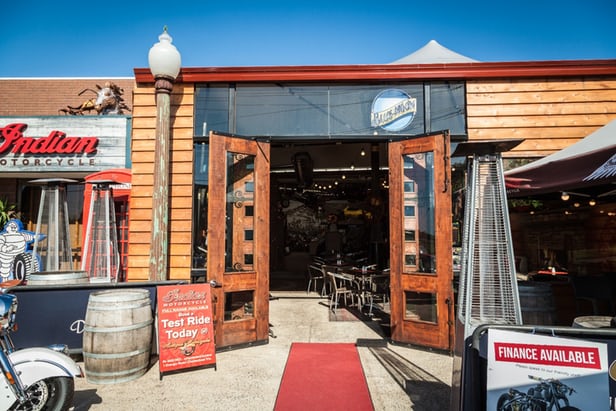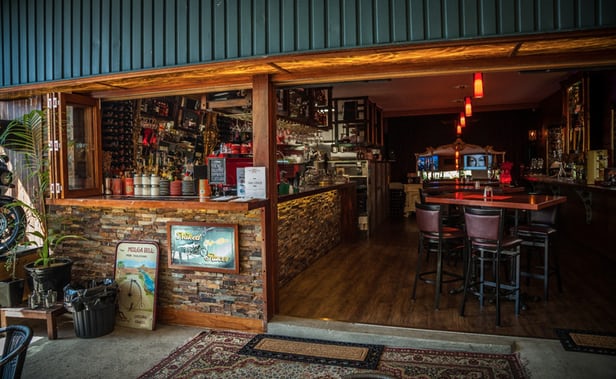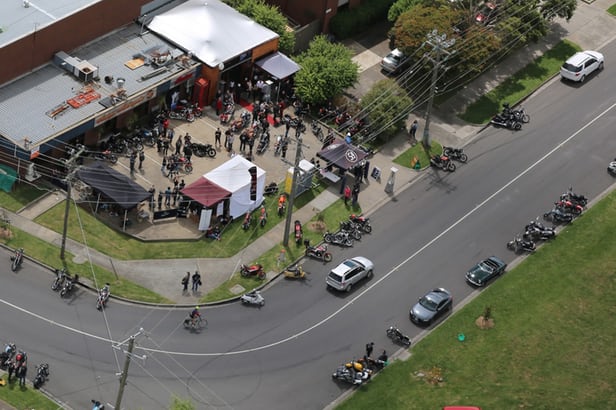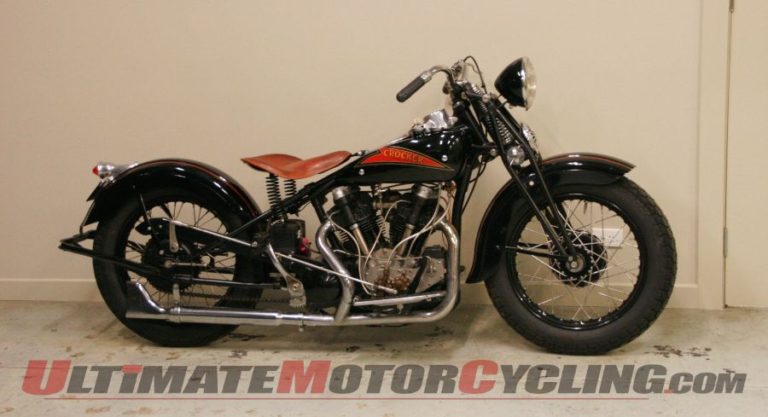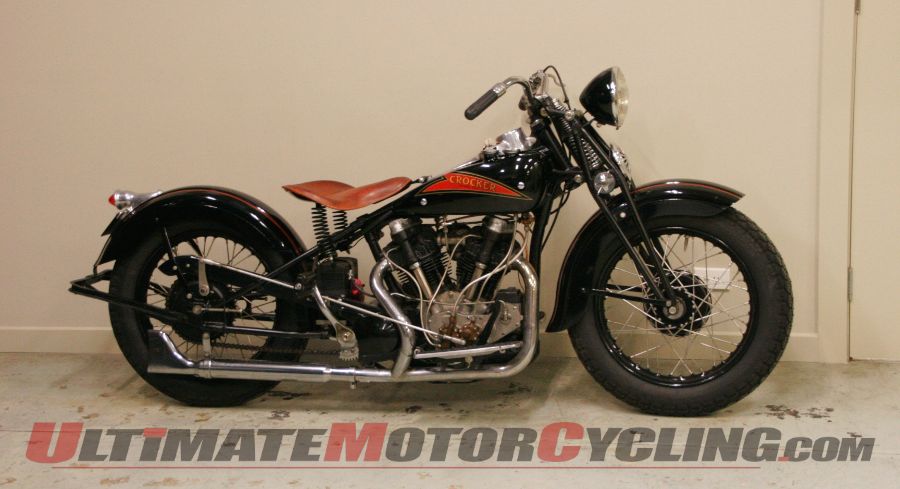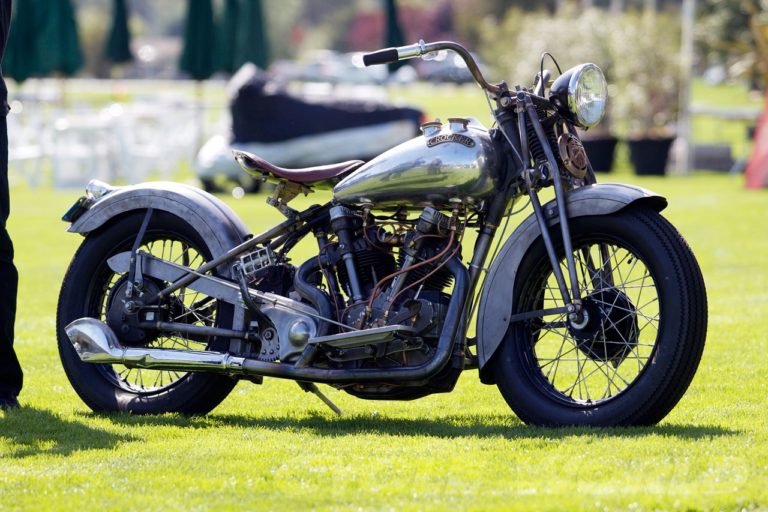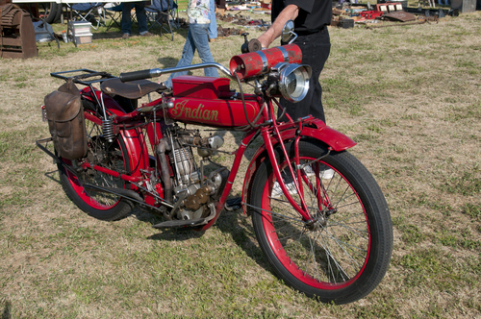John Gee’s extraordinary Antique Motorcycles collection
46 PICTURES
Antique Motorcycles, in Moorabbin, outside Melbourne, Australia(Credit: Loz Blain/New Atlas)
VIEW GALLERY – 46 IMAGES
Tucked away in Melbourne’s urban sprawl is one of Australia’s true hidden gems. Antique Motorcycles features the amazing and ever-changing motorcycle collection of owner John Gee, who was nice enough to take us on a guided tour and tell us about some of his favorite machines.
I’ve lived in Melbourne, Australia nearly 40 years, and been into motorcycles for about half that – and yet this hidden treasure has somehow managed to remain completely off my radar until now. Tucked away beside Moorabbin Airport is a historic motorcycling wonderland, almost a museum, built on one man’s personal collection.
Antique Motorcycles is a monument to owner John Gee’s passion for anything interesting with two wheels. Walking in the front door, through the cafe/bar area, you step into a huge showroom/museum area where dozens upon dozens of bikes sit in beautifully chaotic displays. Model planes, minibikes, snowmobiles, bicycles and speedway cars hang from the rafters, and the place is chock-full of all kinds of memorabilia.
John took the time to take us through the museum area and talk about a few of his many favourites. We’ll let him take it from here in his own words:
Antique Motorcycles started in 1988, believe it or not. I’ve been going to the States since 88, buying classic bikes and bringing them back to Australia.
I got bitten by the motorcycle bug as an 8-year-old and the bug kept getting worse. By the time I was an apprentice motorcycle mechanic at 17, I owned half a dozen road bikes that I kept at a friend’s house so my parents wouldn’t know. It was around this time I started buying and selling bikes, and building a collection.
In the late 80s, I was traveling across the United States, and I noticed that Triumphs, Nortons and BSAs were cheap. So I planned a trip over there, went and bought 30-odd bikes, shipped them back, and I’d spend the year doing them up in the garage. Eventually when you amass a collection of motorcycles it attracts other people with the same passion. Before you know it, you’re importing bikes for other people and working on their projects for them. One day you wake up and you own a motorcycle shop! It doesn’t happen overnight, but if you do it long enough, you end up with a place like this.
We’ve got a bit of everything here. I’ve got a pretty big mini-bike collection – a hangover from that bug I had as a kid. I prefer original condition bikes. I’ve spent most of my life taking chopper forks and handlebars and Craig Vetter fairings and touring bags off motorcycles and returning them to their original condition. I’ve got choppers from the 70s, I’ve got turbo bikes, I like my British bikes, I love my German bikes … but Indians is my #1 passion.
We became a dealer for Indian about 12 months ago. We’re very happy to sell them, they’re not a hard product to sell at all. They sell themselves out of the box because they’re such a good bike. It’s great to see a serious competitor to Harley Davidson.
Destroyer II – Billy Gibbons’ custom Kawasaki Z1R
We’ve got a lot of famous stuff here … This is a bike that Billy Gibbons, from ZZ Top, had made. He called it Destroyer II, because that’s the kind of guitar he plays.
He got a ’78 Z1R turbo, which was probably one of the most expensive bikes available on the day, and he sent it back to the factory. They put a stage 3 kit in it, which is a bigger sump, a welded crank, 6:1 forged turbo pistons, undercut the gearbox, all that sort of stuff.
Then they sent it off to this mob called RC Hill’s of Orlando, and they did all the gold plating, and the painting, and the custom work.
We haven’t restored the seat, because the seat had Billy Gibbons on it. The time’s come, it sort of needs to be done, but I’ve held back, because it’s Billy’s own seat. Pretty cool bike, it’s only done about 6,000 miles.
I found it in a collection in Michigan. I was buying about 20-odd bikes off one guy. It was in a pretty poor state. But they were the fastest bike in the world at the time. They still currently hold the record for an 11-second quarter mile, sitting on the bike backwards. Quite incredible!
Mad Max Honda Four
This bike here’s out of Mad Max. The guy lived five Ks from here, and he came in and said he had an old Honda and he wanted to sell it. I went and looked at it, I didn’t know it was out of Mad Max, he wanted too much money … I was leaving, I was in the car ready to drive away.
But just as I was leaving, he told me the story of how he rode the thing in Mad Max, and I quickly changed my mind and bought it. There’s a picture of it, right here… There was only two Honda Fours in the film.
When you watch the movie and slow it down, you can see the Star mags, you can see the twin-disc front end, which is unusual for a Honda, they only had a single disc front end. And you can see the calipers are behind the fork – normally Hondas had the caliper in front. He customized his own bike, way back when, ’74 or 5.
They had a Mad Max reunion last year. We all went to Clunes. And they had just about every vehicle from every Mad Max film made. All the people in the clothing and whatnot.
I had this bike there, and nobody knew about it – it doesn’t exactly jump off the page. By the end of the weekend, I found out I had the only genuine vehicle out of any of the Mad Max films at the event. There were at least 10 Interceptor cars, and the MFP police cars, 10 or 12 of those … There’s a lot of passion out of there for Mad Max.
TZ750 race bike
Here’s a TZ750, this was one of Trevor Flood’s bikes. Reputedly raced by Michael Dowson … and Kevin McGee in the ’84 Swann series. I think they raced it to second place in the championship.
It’s a GP bike you could buy off the shelf. This one’s got around 130 horse, it’s running Lectron flat-slides, White Power suspension, Dymag wheels and Brembo brakes. All products that the Floods were the importers for at the time. I bought it from a deceased estate about 25 years ago.
I’ve ridden this one on track. You go flat chat down Phillip Island straight, and when you hit the hump where the tunnel goes underneath, the thing does a huge wheelstand and you have to back off. Whenever you ride this bike, you have the utmost respect for it. When you get off in the pits, you’re shaking, and you go “whew… I lived!”
2002 Indian Chief: Schwarzenegger bike from Terminator 3
This is out of Terminator 3, Arnie Schwarzenegger. They made four bikes, they destroyed two, and two survived. This is the one he actually rode in the scene where they’re chasing the crane truck, and the crane’s jib is pointed sideways and the whole world’s blowing up. It’s taking down the power lines, flipping all the parked cars upside down. Pretty spectacular scene.
This particular Indian was known as the Gilroy Indian. Made in Gilroy, California. Not to be confused with the Polaris product of current times, which is a much superior motorcycle. The chase scene was only a small part of the movie, but Indian fans would’ve been sure to notice what Arnie was riding. It was the first time an Indian had been used in a movie in a very long time. They had a lot to live up to, as previous Terminator chase scenes involving Harleys were also spectacular.
Honda CBX1000 Turbo
In 1978, Honda came out with the CBX1000 six cylinder. A stunning bike, with a motor that was described as “a block of flats.” Absolutely an instant classic. So what to do to improve it?
Meet the Honda CBX turbo! They only made 10 kits, which were dealer fitted. They weren’t factory endorsed, but the factory would’ve been happy they had a product that could run with the Kawasaki Z1R turbos of the time … So that’s one of ten of those. I’ve had a fascination for turbos and have owned many examples, from all the four Japanese brands. I currently still have quite a few, and also some pretty wild Frankenstein home-built turbo bikes. Always fun.
This kit doubles whatever horsepower it had. What’d they have, like, 75 horsepower new? Not much … It might have 140 now.
1942 Harley-Davidson WLA
This WLA was restored by the US army, it’s probably the best example of a WLA in the world. It’s cool shit. Like all bikes here, it goes. Bit of fuel, bit of choke, couple of prime kicks, ignition … (bike starts) Hey? Not bad!
It had the radio instead of the Thompson machine gun. It’s a communication bike. It’s probably the best example of a WLA in the world, since it was restored by the army. It’s not like WLAs are very rare – they made 90,000 of them. But they are rare to find like this.
I didn’t have to do any work on it. The work I had to do was count out the bills and hand ’em over. Haha! Serious stuff. This bike is now owned by one of our very best customers, and is part of his extensive collection.
1951 Harley-Davidson WR
WR Harley-Davidson up there, a 1951 WR, they made 23 in the world. That was Harley’s weapon on the flat tracks. This bike comes from one of the oldest Harley Davidson shops in the USA. It was a spare bike that only saw a few practice laps in its life.
In ’52, they already had the KR top end on the WR – the WR was on its way to morphing into the KR. By ’53, WRs were gone and the KR was born. Very fast bike for the time. They’d pull wheelstands down the main straight at over 80 miles an hour, I’ve seen it myself at the Davenport flat track.
1966 Triumph Bonneville XR750
That’s a Triumph. We use that to test whether people know their shit or not. You just failed. Haha! I just put a Harley tank on a Triumph, because it fit … I was building a bike to race in New Zealand at the Burt Monroe challenge, and the tank came up in Just Bikes magazine, and it had a brand new paint job on it, so I stuck it on there. I was reluctant to take the Harley badge off, because I didn’t know if I was going to keep that tank.
One thing led to another, next thing, people are coming in and telling us they used to have one exactly like it … We left it on there for a bit of fun, we use it to qualify people. It’s amazing how many people will swear black and blue, that that’s exactly how the one they owned was – much to our bewilderment!
1975 Hercules Wankel
We’ve got two Hercules rotaries, we’ve got two Norton rotaries, the water-cooled and the air-cooled, and a Suzuki RE5 Wankel.
They’re a different thing to ride. We don’t call ’em a motorcycle, we call ’em rotorcycles. They’re a bit … heavy and slow to get going, but they’re quirky, and we still like ’em. When I was an apprentice motorcycle mechanic, we used to work on these things. I’ve got fond memories. We used to look at the engine and go “what the hell do you do with that?”
The Hercules is a very surprising motorcycle to ride. It is very quick off the line, it has unexpected power delivery, and it’s very quick and nimble. Quite the opposite to the Suzuki RE5.
The Garage display
That’s the old garage. We use all the stuff in here. It’s all rare stuff. ’23 Indian, there’s a ’39 Indian engine, a ’38 Indian engine, all kinds of important stuff in there. Transmissions, magnetos, carburetors … Whenever we’re restoring an old bike, this is where we come to get our bits.
We did it up like an old ’20’s servo you’d find in outback Australia. Couple of gas pumps out the front, a collection of stuff under a lean-to. We’ve got a bit of junk piled up in there today, it’s not really as good a display as it normally is …
Steve McQueen sidecar
Chad McQueen was just in Australia. I know Chad from the States, he’s one of those identities that kind of turns up at a lot of things.
I met him up at the Rock Store once, up on Mulholland Drive. He was driving an old Porsche. I just noticed this car, you know, it had cut slicks, and a full camber job, and all the body panels were fiberglass, and racing seats … It was a pretty rough old looking car.
I was looking at it, and this guy yells out from across the street, “get in! knock yourself out!” Like Americans do … Next minute, of course, he’s there, and he’s on for a chat. I was asking questions about his car, like how fast does it go, it looks pretty serious … He said “aw look, I’ve lost my nerve these days, after I hit the wall at Daytona doing 200 …” I was thinking to myself, typical American, bragging, or making up stories …
Anyway, he said “what’ve you guys got?” Well, I told him we had a rental car and we weren’t very proud of it, we’d parked it ’round the corner. But we’re into Indian motorcycles in a big way, and that’s what we ride at home. He said he had an Indian motorcycle with a sidecar. So we listened to his story about that. And I said, well, I’m not a fan of sidecars, but I do have one. I only keep it because it belonged to Steve McQueen … And he said “well that mah daddy!” And then I realized, shit, this is Chad McQueen – and that story about hitting the wall at Daytona at 200, that was actually true!
That’s the sidecar up there, and that’s the bike it was on, down below. It got caught in a fire at my previous address – one of the buildings burned down. It got a bit singed, but it’s still in pretty good condition. And I told him about it. He remembered the bike – and he said he hated it, because his dad used to make him polish it! Pretty funny.
1951 Indian Squad bike
This is my favourite Indian, it’s a 1951 New York police bike. It’s got a siren on it, still. I bought it off the original cop. Some of the towns, depends where you came from, you had to own the bike to be a cop. I don’t think that’s what happened to him, I think this was a fleet bike.
It was never a pursuit bike, it was a parade bike. So, when the president or whoever came to town, there’d be two of these out in front and two behind as a police escort, that kind of thing.
I’ve ridden it around the grand canyon, I’ve ridden it around New Zealand … It’s been my rider for about 25 years now. I can’t put my finger on why, this bike has something that reaches out to me. Whenever I’m going out for a ride, I look round the shop, and I always end up choosing this one. Actually I’d better get that bike up on the bench, I’ll be riding it the weekend after next. We’re going up to Mansfield in the high country. We’re doing the 25th annual Great Race – Harley vs. Indian.
2016 Indian Scout custom cafe racer
Here’s one we’re building right now, a cafe racer, something a bit different. It’s home grown, right here. We’re just giving people examples of what can be done using a Scout as a base. It’s about getting people’s imagination going, so they can then buy a bike and either get us to customize it, or run off and go and customize it themselves. It’s an awesome platform – 100 horsepower and very nimble handling.
1974 Norton Commando (supercharged)
There’s another bike up here that’s a bit far out … That’s a supercharged Norton Commando. You could buy a kit back in the 70s, bolt on a Drouin supercharger, and double your horsepower. So that’s just one that I knocked up. It’s a … let me think, a ’74 Commando. It’s got a Dunstall kit, Norman Hyde fork brace, alloy rims and clip-ons, a 2-into-1 exhaust …
Not everything’s for sale. Obviously I got into this because I was passionate about bikes and I wanted to build a collection of bikes. All of a sudden you end up being a motorcycle shop, and you’re buying and selling and you’re head-first into it.
But my passion is still collecting. And there’s still plenty of bikes on my bucket list that I want to get before I’m done. So once in a while, maybe I’ll sell a couple of bikes to get something else on my bucket list. It’s about experiencing them.
I got to about 130 bikes in my collection, that was stupid, I couldn’t keep the tires pumped up. It was a major job just looking after them, and there were bikes in there that were quite rough. So I cut it back. I’m probably at about 70 or something at the moment. I try to keep it round about there.
I’ve got a warehouse over the road, I keep a bunch more over there. I like to swap ’em around, keep it all alive. This isn’t a museum you walk into one time – you come back next week, it’s different. Come back the week after, it’s different again. There’s always a reason to come back.
Same with the museum we’re building upstairs. I know a lot of people with collections of very rare and exotic motorcycles. We’ll do a Brough Superior display, we’ll do a Harley-Davidson display, we’ll do all sorts of things, maybe an American brand display with Thors and Merkels and Popes, things like that. It’s always going to be changing, so it’s important to keep coming back.
Friday nights we have our Tapas night, which is where we open the bar and get drunk. There’s some live music, lots of fun. Two bands every Friday, and the cafe’s open every day except Sunday. So there’s the new Indian dealership, and the workshop and the team of mechanics. We work on vintage and classic bikes, which not a lot of shops would touch.
We’ve also got the Classic Racer Club based at the shop, we have rides every Saturday morning, 8 o’clock, heading off in whatever direction the riders choose on the day. Anywhere between 5 and 40 bikes, it depends who turns up.
After several hours chatting with John and photographing the bikes out back, I never felt like I’d scratched the surface of what’s in there – and John’s perfectly happy about that, telling me I should come back again and feature more of the bikes he rotates in and out of the museum.
We might take you up on that, John! There’s a ton of other stuff in the shop we’d love to feature.

